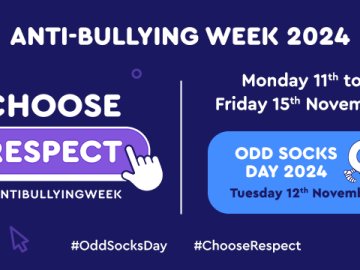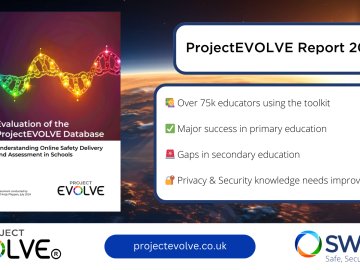There are plenty of things on the internet that can give you a fright, but that doesn’t mean you have to live your life hidden behind the sofa cushions. With a plan in place and tools to tackle online terrors, browsing should soon seem a lot less spooky. (Yes, this article is Halloween-themed. No, the awful jokes are not stopping here.)
Open any newspaper, turn on any TV channel, or visit any website (sweet irony), and you’ll be sure to find a story decrying the dangers of being online.
Sure, there are harms online… A bit like there are harms in the ‘real’ world. Strange, then, that the majority of us leave our houses with relative ease and confidence every day but, if you listened to the frenzied crowds, you’d be amazed that anybody who has ever used the internet has made it out in one piece.
Get your proton packs ready, it’s time to bust some online ghosts and get you walking the e-streets in confidence.
Phishing
The first trick to face up to is one of the oldest in the book. Phishing – a type of online fraud – involves sending emails/messages imitating a genuine business or person in an attempt to trick the recipient into sharing personal information (e.g. bank account details or passwords). The email is the bait, the fraudsters are the angler, and you – they hope – are hungry enough to take a bite.
It may be a well-known trick but “on average 4% of people in any given phishing campaign will click it” (p.12). That’s a lot of clicks, and a lot of damage potentially caused to those involved.
How to treat it: Stay switched on. Before you do anything with a suspicious-looking email, double check:
- Does the email address of the sender look official or is it a string of random letters and numbers, or a personal email address claiming to be someone from a business? (e.g. john@mail.com claiming to be HMRC)
- Are there obvious grammar and spelling mistakes in the email? Companies employ teams of copywriters and email marketing specialists – the chances of them including mistakes (“acount”) and improper phrasing (“click here validate your password”) are slim to none.
- Are they asking for personal information? No legitimate company will do this! Treat any email that asks you to provide your account or payment details as highly suspicious.
If you’d like to learn more about how phishing scams work and how to prevent them, visit our Phishing Tackle hub - it's got all the information you could want .
Loot Boxes
Moving on to a far more modern issue, loot boxes are one of the most recent scare stories to take up space in the papers – and it’s understandable why.
Before we go into the details, let’s have a really quick primer on loot boxes.
Loot boxes are virtual items users can purchase in games with real money. In the box, users will find a randomised selection of items that customise or alter the user’s experience of the game. They carry the potential to make a big difference to gameplay and they have caused quite a storm.
Loot boxes are under scrutiny because some people believe they mimic gambling and an inquiry by the Department for Culture, Media, and Sport called for the regulation of loot boxes under gambling law and ban their sale to children.
How to treat it: Have an honest conversation with your kids about loot boxes. Make sure they know that:
- They are spending real money
- Games may be engineered to encourage them to purchase such items
- If you feel it is appropriate, you can set up parental controls for purchases
The UK Safer Internet Centre has produced a guide explaining 11 things you should know about loot boxes. We recommend taking a look if you want more information about this new feature of the online landscape.
‘Digital Ghost Stories’
They come around at all times of the year – not just October – and some Digital Ghost Stories can cause unrivalled panic and concern amongst parents and carers.
Hold on – what do we mean by Digital Ghost Stories?
Fuelled by sensationalist headlines and social media, these wildfire stories start with the best intentions. A well-meaning parent or teacher hears about a new craze – a game, a challenge, an app, or a message that is putting our kids in serious danger – and shares a warning on social media. It might not have any basis in fact, but it sounds scary and it’s enough to spike concern. The post gains traction. A journalist sees it. The story reaches the papers and before you know it, a new Digital Ghost Story has been written.
Somehow, despite there being no evidence of the craze existing or producing any of the purported outcomes, the nation has been whipped into a frenzy that – ironically – only increases interest in the Digital Ghost Story.
We wrote at the start of 2019 about one such story and Professors Andy Phippen and Emma Bond wrote an analysis of the situation. It’s well worth a read and can be accessed for free via our website.
How to treat it: Don’t fan the flames.
- Think critically when you see stories such as this and check to see if the evidence stacks up
- See if organisations such as the UK Safer Internet Centre have shared information about what you are reading
- Take sensationalist stories with a pinch of salt
Fake News
It’s not just a presidential proclamation – it’s a real issue that reaches every corner of the world and it’s striking fear into the hearts of many.
Fake news is as self-explanatory as it is ghoulish: it’s news and stories that are misrepresenting facts or completely untrue. Little white lies and porkies didn’t previously mean so much but, in the age of social media, these falsehoods can spread quickly – sometimes far faster than the truth can keep up with.
Whether it’s about nuclear weapons, vaccines, or a celebrity death, fake news is damaging and dangerous to the fundamentals of our society.
How to treat it: By practicing and promoting critical thinking with the young people you know. It’s something we could all do with working on from time to time!
Why not find some examples of debunked fake news and identify common themes that you can look for in future stories you read?
- BBChave a great series of videos that can help you spot fake news from real news
- Social media companies have been busy creating tools to help users report fake news, with Facebook introducing a raft of measures to limit the spread of fake news
- Instagram also announced the addition of a fake news option to its reporting tools in September 2019
Hate Speech
In the two years between March 2016 and March 2018 (the latest data available from the House of Commons Library), reports of hate crime increased by 35%. A 2011 research paper concluded that “history and social science confirm that hate speech may facilitate acts of violence against members of targeted groups.”
It is clear that hate speech is a stepping stone to hate crime and violence. Fighting its rise is imperative for all of us if we want to live in a fair and kind society.
The advent of the internet and, with it, connection across societal and geographical borders has revolutionised our communication and the sharing of knowledge. It has also made the spread of poisonous ideologies and voices more rapid and pervasive. Hate speech and the ideologies behind it incubate online, so new approaches are required if we want to stop this scourge at source.
How to treat it: By hacking hate.
- The SELMA project, of which SWGfL is a partner, is a movement to end online hate speech through a toolkit of Social and Emotional Learning, Media Literacy, and Citizenship Education resources
- It contains over 100 resources that are customisable and relevant to all ages
- Clear, continued long-term guidance as to how to build more comprehensive and sustained pathways of change
Pornography
One of the oldest horror stories going is kids having access to adult content. When 15% (3/20) of the most visited websites in the world contain such material, it’s no surprise that 4 in 5 parents are concerned about exposure to pornography.
Research conducted by the British Board of Film Classification in the summer of 2019 found that “51% of the 11-13-year olds reported that they had seen pornography at some point”.
In fact, the “majority of young people's first time watching pornography was accidental, with over 60% of children 11-13 who had seen pornography saying their viewing of porn is unintentional”.
Whatever your thoughts on pornography, we can all agree that preventing young people from accessing content that they don’t intend to see is a good idea.
How to treat it: Go beyond the birds and the bees.
- Starting a conversation about porn with your child is never going to be easy, but many parts of being a parent are difficult!
- Be open, honest, and start from a position of trust. As you well know, the quickest way to get a teenager’s hackles up is to start pointing fingers and making accusations
- Check what kind of filtering you can put in place on the devices to which your child has access
A comprehensive guide to practical resources addressing online pornography can be found on the UKSIC website.
Catfishing
Do you know everyone on your friends list? How about the people behind each account you follow? The internet allows us to reach out beyond our usual networks and meet people who share our interests and can change our worldview. It’s brilliant… But it also means that we can’t guarantee everyone is who they say they are.
The phrase entered common parlance with the arrival of the documentary and subsequent TV show ‘Catfish’ – telling the stories of those who have been misled by fake romantic interests online.
Catfishing is a type of phishing – deceitful online communications for personal gain (whether monetary, social, or personal) – and perpetrators can have a number of reasons for their behaviour, including exploring identity, financial gain, or continuing previous patterns of abusive behaviour.
How to treat it: With a pinch of salt.
- Has the person contacted you out of the blue? Do their pictures look too good to be true or inconsistent from one to the next?
- Do they refuse to video call or send pictures to you?
- If you reverse image search their pictures, do they appear on profiles attached to any other names? (Read this article by the Revenge Porn Helpline for a great guide on reverse image searching. And don’t worry – it’s Safe for Work!)
If you’ve answered yes to any of the above, you might be right to be suspicious. It’s unlikely you’ll be able to get confirmation of your concerns, so the best steps you can take are to practice healthy scepticism and don’t give too much of yourself to people you don’t know online.
Data Protection
Since the dawn of GDPR in 2018 (that tremor you just felt was the collective shudder of Compliance professionals across the country), businesses and organisations of all sizes have had to beef up their data protection. They now have to ensure they have consent, legitimate interest, and a time limit for collecting and processing personal data.
It’s scary, huh? Especially for SMEs and organisations such as schools and colleges, where there are no teams of legal and data experts.
How to treat it: With a little help from SWGfL.
- If you are a school or educational institution, we’ve written a comprehensive guide to GDPR that is broken down into easy-to-manage sections. It covers everything you need to know (and should have been doing since May 25 2018!) and will make managing your GDPR concerns a breeze.
- If you are a business or any other organisation, we recommend reading this primer on GDPR from cyber security experts Securious.
Don’t put it off! With organisations facing fines of as much as 4% of their annual turnover, a data breach could now do serious damage to an organisation’s future and viability. And that’s not to mention the serious reputational damage a breach can incur.
And all the rest...
There are plenty of other spooky goings-on online - but we can only tell you so much in one article!
Hopefully you feel equipped and ready to tackle some online horror stories, but if you’re looking for more advice, you can always read some other articles in our Magazine or you can check out our long list of free resources for parents and carers, teachers, young people, and everyone else.






